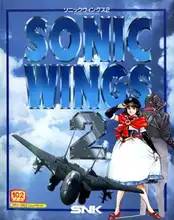Retro Thrills: Diving into Vertical Scrolling Shooter Classics
Step back in time, past the 3D polygons and open worlds, to an era defined by pure, unadulterated action scrolling relentlessly upwards. This is the golden age of the Vertical Scrolling Shooter, a genre that demanded twitch reflexes, pattern recognition, and a healthy supply of quarters (or lives, if you were at home).
These top-down power fantasies, where you control a lone ship or hero blasting through waves of enemies, were a staple of arcades and early home consoles. They offered a unique perspective, pushing you ever forward into the unknown, a constant stream of foes and environmental hazards filling the screen.
What Makes Vertical Scrolling Shooters So Addictive?
Unlike their horizontal counterparts, vertical shmups (a common nickname for shoot 'em ups) create a distinct sense of forward momentum and vulnerability. You're not just moving left or right; you're advancing into enemy territory. This perspective forces you to think differently about dodging and positioning.
Think about it: the threats usually come from above or the sides, requiring quick lateral movements and weaving through tight bullet patterns. Power-ups are often crucial, transforming your meager starting shot into a screen-clearing spectacle. The challenge is steep, often relying on memorization and pixel-perfect dodging, leading to that "just one more try" loop that defined so many retro arcade experiences.
A Blast from the Past: Iconic Vertical Shmups
While the genre has roots stretching back to titles like Atari's Sky Raider (1978) or the seminal Xevious (1982), the 8-bit and 16-bit eras truly solidified its place in gaming history. Consoles like the Sega Genesis/Mega Drive became veritable havens for these high-octane experiences.
Here are just a few gems that defined the Vertical Scrolling Shooter genre for a generation:
- M.U.S.H.A. (Sega Genesis/Mega Drive): Often cited as one of the best on the system, this entry in the Aleste series by Compile featured fantastic graphics, a killer soundtrack, and satisfying mech-based gameplay. It's a prime example of 16-bit vertical shooting done right.
- Truxton (Arcade, Genesis/Mega Drive): A classic from Toaplan, known for its difficulty and intense action. It brought that raw arcade feel home, demanding precision and quick reactions.
- Raiden Trad (Arcade, SNES, Genesis/Mega Drive): The home port of the arcade hit Raiden delivered solid vertical shooting action. While maybe not the flashiest, it offered dependable gameplay with its signature weapon types and bomb system.
- Elemental Master (Sega Genesis/Mega Drive): A unique fantasy-themed vertical shooter from Techno-Soft. It stood out with its excellent music, selectable stages, and elemental weapon system, offering a slightly different pace than pure sci-fi blasts.
- Fire Shark (Arcade, Genesis/Mega Drive): Another Toaplan classic, this time with a WWI theme. Like Truxton, it's a straightforward, challenging shooter that embodies the arcade spirit.
- Twin Hawk (Arcade, Genesis/Mega Drive): A WWII-themed helicopter shooter that let you call in extra planes as bombs. A solid, affordable title for fans of the era.
- Vapor Trail (Arcade, Genesis/Mega Drive): Brought to the Genesis by Renovation, this was a competent vertical shooter with a focus on different weapon types and shields.
These games, and many others like Dangerous Seed, Master of Weapon, Phelios, and Task Force Harrier EX, defined countless hours for players seeking that intense arcade thrill at home. They pushed console hardware, showcasing impressive sprite work, parallax scrolling, and often, surprisingly good music.
The Enduring Appeal
Why do we still look back fondly on these vertical scrolling shooters?
- Pure Gameplay: They strip away complexity, focusing on core mechanics: shoot, dodge, survive.
- Visual Spectacle: Despite technical limitations, they often featured vibrant colors, detailed sprites, and massive, multi-jointed bosses.
- The Challenge: Beating a tough vertical shmup feels like a genuine accomplishment. It's a test of skill and perseverance.
- Nostalgia: For many, these games are tied to childhood memories of arcades, sleepovers, and discovering the power of 16-bit machines.
Where Can You Experience Them Today?
The great news is you don't need to track down original cartridges (unless you want to, of course!). Many classic Vertical Scrolling Shooter titles are available digitally on platforms like GOG.com or modern console collections. Emulation via tools like DOSBox or console emulators also allows you to revisit these gems on PC. Websites like Archive.org even host playable versions of some vintage PC titles.
Whether you're a seasoned shmup veteran or curious about the genre's origins, diving into a classic Vertical Scrolling Shooter is a fantastic way to reconnect with the golden age of arcade action.
FAQ
Q: What's the difference between a vertical and horizontal scrolling shooter? A: In a Vertical Scrolling Shooter, the screen moves upwards (or occasionally downwards), and the player typically moves left and right to dodge. In a horizontal scrolling shooter, the screen moves sideways (usually right), and the player moves up and down.
Q: Are vertical shmups generally harder than horizontal ones? A: Difficulty varies greatly by game, but vertical shmups often feature dense bullet patterns and enemies attacking from above, requiring different dodging strategies compared to horizontal games.
Q: What does "shmup" mean? A: "Shmup" is a common shorthand for "shoot 'em up," the broader genre that includes both vertical and horizontal scrolling shooters, as well as arena shooters.
Q: Are there modern vertical scrolling shooters? A: Yes! While the retro era was a peak, independent developers continue to release excellent modern vertical shmups, often featuring intense "bullet hell" patterns.
What are your favorite Vertical Scrolling Shooter games from the retro era? Share your nostalgic picks in the comments below!

